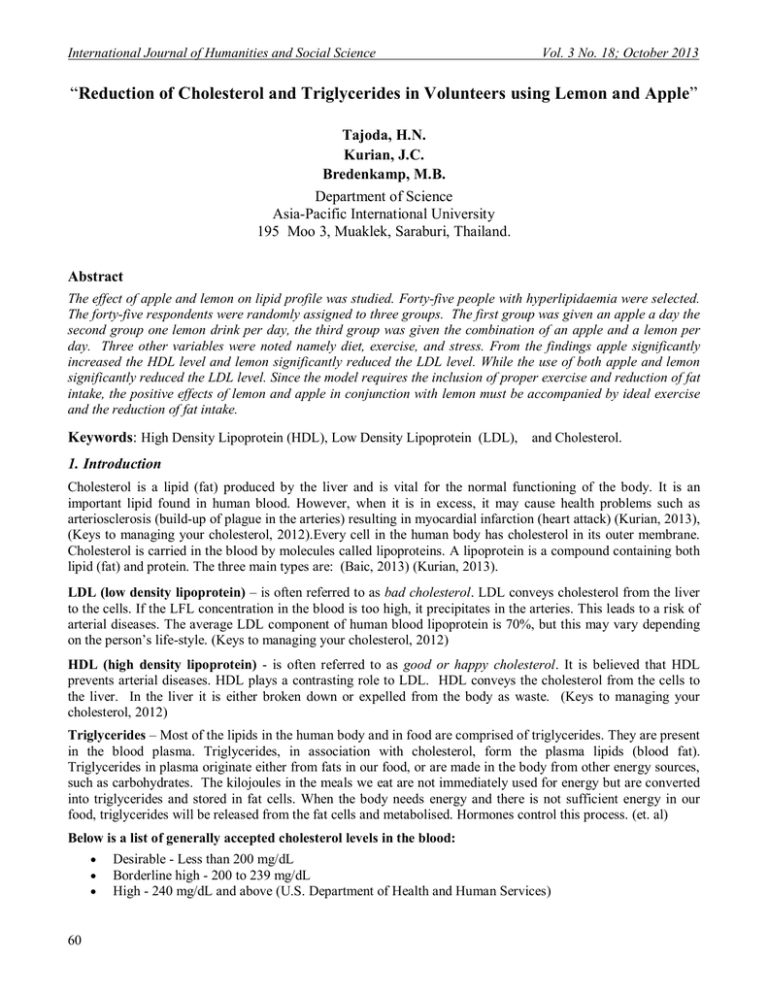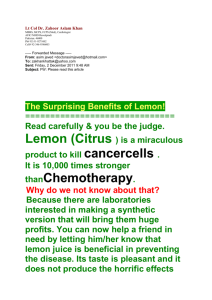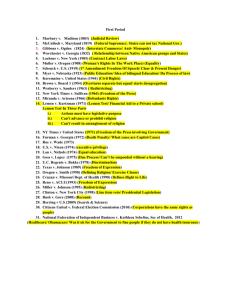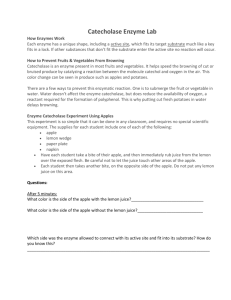Document 10465349
advertisement

International Journal of Humanities and Social Science Vol. 3 No. 18; October 2013 “Reduction of Cholesterol and Triglycerides in Volunteers using Lemon and Apple” Tajoda, H.N. Kurian, J.C. Bredenkamp, M.B. Department of Science Asia-Pacific International University 195 Moo 3, Muaklek, Saraburi, Thailand. Abstract The effect of apple and lemon on lipid profile was studied. Forty-five people with hyperlipidaemia were selected. The forty-five respondents were randomly assigned to three groups. The first group was given an apple a day the second group one lemon drink per day, the third group was given the combination of an apple and a lemon per day. Three other variables were noted namely diet, exercise, and stress. From the findings apple significantly increased the HDL level and lemon significantly reduced the LDL level. While the use of both apple and lemon significantly reduced the LDL level. Since the model requires the inclusion of proper exercise and reduction of fat intake, the positive effects of lemon and apple in conjunction with lemon must be accompanied by ideal exercise and the reduction of fat intake. Keywords: High Density Lipoprotein (HDL), Low Density Lipoprotein (LDL), and Cholesterol. 1. Introduction Cholesterol is a lipid (fat) produced by the liver and is vital for the normal functioning of the body. It is an important lipid found in human blood. However, when it is in excess, it may cause health problems such as arteriosclerosis (build-up of plague in the arteries) resulting in myocardial infarction (heart attack) (Kurian, 2013), (Keys to managing your cholesterol, 2012).Every cell in the human body has cholesterol in its outer membrane. Cholesterol is carried in the blood by molecules called lipoproteins. A lipoprotein is a compound containing both lipid (fat) and protein. The three main types are: (Baic, 2013) (Kurian, 2013). LDL (low density lipoprotein) – is often referred to as bad cholesterol. LDL conveys cholesterol from the liver to the cells. If the LFL concentration in the blood is too high, it precipitates in the arteries. This leads to a risk of arterial diseases. The average LDL component of human blood lipoprotein is 70%, but this may vary depending on the person’s life-style. (Keys to managing your cholesterol, 2012) HDL (high density lipoprotein) - is often referred to as good or happy cholesterol. It is believed that HDL prevents arterial diseases. HDL plays a contrasting role to LDL. HDL conveys the cholesterol from the cells to the liver. In the liver it is either broken down or expelled from the body as waste. (Keys to managing your cholesterol, 2012) Triglycerides – Most of the lipids in the human body and in food are comprised of triglycerides. They are present in the blood plasma. Triglycerides, in association with cholesterol, form the plasma lipids (blood fat). Triglycerides in plasma originate either from fats in our food, or are made in the body from other energy sources, such as carbohydrates. The kilojoules in the meals we eat are not immediately used for energy but are converted into triglycerides and stored in fat cells. When the body needs energy and there is not sufficient energy in our food, triglycerides will be released from the fat cells and metabolised. Hormones control this process. (et. al) Below is a list of generally accepted cholesterol levels in the blood: 60 Desirable - Less than 200 mg/dL Borderline high - 200 to 239 mg/dL High - 240 mg/dL and above (U.S. Department of Health and Human Services) © Center for Promoting Ideas, USA www.ijhssnet.com Dangers of high cholesterol levels Atherosclerosis - narrowing of the arteries. Higher risk to coronary heart disease - an abnormality of the arteries that supply blood and oxygen to the heart. Heart attack - occurs when the supply of blood and oxygen to an area of heart muscle is blocked, usually by a clot in a coronary artery. This causes that portion of the heart muscle to die. Angina - chest pain or discomfort that occurs when the heart muscle does not get enough blood. Other cardiovascular conditions - diseases of the heart and blood vessels. Stroke and mini-stroke - occurs when a blood clot blocks an artery or vein, interrupting the flow to an area of the brain. This can also occur when a blood vessel ruptures and a part of the brain dies. (et. al) Some studies have shown the impact of eating a more fiber-rich plant based diet in reducing the undesired LDL and to elevate the healthier HDL cholesterol (Gardner, C. D., Coulston, A., Chatterjee, L., Rigby, A., Spiller, G., & Farquhar, J. W.,2005). Daily intake of 5-10 grams of soluble fiber can reduce total cholesterol by 3-5%. The strongest dietary agent for reducing LDL cholesterol is apples. Eating one apple daily for four weeks reduces LDL cholesterol up to 40% (An Apple a Day Might Keep Cholesterol Healthier, 2002) and cholesterol-lowering effect of 5-8% by Peter Ropas in his study of “Apples Their Antioxidants and benefits to Human Health” May 2010. Apples have lowering blood-cholesterol level because it has pectin that enhances digestive health according to Hara Estroff Marano in his “Apples Are the New Fish” (2010). Lemon was also found to dramatically reduce total cholesterol (Kurian, 2013), (Reams, C.). The effectiveness of apple in the reduction of lipids especially that of LDL has thus been reported in rats in the study of rats by (Nasiru, 2012) (Boyer, 2004) and likewise that of lemon (Khan, 2010). However, a study to the synergistic effect of apple and lemon has not been reported. This paper reports the value of combining the use of apple and lemon for the improvement of the reduction of blood cholesterol and triglycerides. From a report provided by a hospital in Thailand, for a certain period of time in the year 2011, 38 patients were either hyperlipidaemic or hyperglyceridemic. However during this same period, only 24 patients were diabetic and 97 cases of acute upper respiratory infection were treated. From these figures it is evident that the cholesterol related illnesses, hyperlipidaemia and hyperglyceridemia seem to be a recent concern. 2. Materials and Methods This was an experimental study with three treatment groups. Forty-five people with hyperlipidaemia were selected. The 45 respondents were randomly assigned into three groups. The first group was given apple (one apple per day), the second group lemon (one lemon per day), the third group was given an apple and a lemon per day. Three other variables were controlled namely diet, exercise, and stress. These variables were measured by questionnaires. The forty-five volunteers were employees of Adventist institutions (AIU, AIMS) and several Adventist church members who were diagnosed to have hyperlipidaemia (cholesterol level above 230 mg/dl) the respondents of this study all signed the Informed Consent from.. The data was analysed using a multiple linear regression method with dummy variables at 5% significant level. 2.1 Sample Collection-Research conducted by volunteers on the AIU campus For our study 45 volunteers participated in a one month program of lowering their LDL Cholesterol and Triglycerides using apple and lemon juice. The initial readings obtained were carefully recorded. The 45 volunteers were divided into three groups of 15 participants each. The first group was provided one apple a day. This apple was eaten under the supervision of the researcher. The second group was given a specific concentration of lemon juice which was also drunk under the supervision of the researcher. The third group was given an apple and a glass of lemon juice which was drunk under the supervision of the researcher. After one month of daily use tot he assigned apple and or lemon drink, the second reading of the LDL Cholesterol and Triglycerides were recorded and compared with the initial readings. It is interesting to note that the volunteers who took the regular glass of lemon juice for a month showed the best results in the lowering of blood LDL Cholesterol and Triglycerides. 61 International Journal of Humanities and Social Science Vol. 3 No. 18; October 2013 The second best result came from those who took both apple and lemon juice and the third group who took the apple only also showed a significant drop in their levels of LDL Cholesterol and Triglycerides. These findings should be encouraging to all who fear of developing some form of cardiovascular disease. They can easily avoid these dreadful ailments by simply eating apples and drinking a glass of lemon juice every day. 2.2 Statistical Analysis Does the consumption of apples and lemon juice reduce cholesterol while exercise, fat intake, and stress are being controlled? Multiple linear regression was employed to predict the effect of eating an apple a day, drinking lemon juice, and apple in conjunction with lemon consumption on cholesterol levels. The use of multiple regression requires that no collinearity and no heteroschedasticity be found in the model. However, collinearity does exist between the consumption of apple, lemon juice together since tolerance is zero and no value of VIF (variance inflation factor) was determined, as shown in Table 1. When apple in conjunction with lemon juice was removed, thus removing apple from the model, no collinearity existed. The VIF for all independent variables are close to one and less than 10 which means no severe collinearity is revealed (Ken, 1997). Neither is heteroschedasticity found since the distribution of standardized residual and standardized values of independent variables (Pred) was random (Tabachnick & Fidell, 2013) as shown in Figure 1. Table 1: Multicolinearity statistics Statistic Ap Lem ApLem Tolerance 0.000 0.000 0.000 VIF Statistic Excer Ap Lem Tolerance 0.696 0.718 0.872 VIF 1.437 1.392 1.146 Statistic Excer Lem ApLem Tolerance 0.725 0.718 0.872 VIF 1.378 1.393 1.146 Excer 0.872 1.146 Fat Int 0.884 1.131 Fat Int 0.884 1.131 Fat Int 0.884 1.131 Stress 0.906 1.103 Stress 0.906 1.103 Stress 0.906 1.103 Figure 1: The distribution of standardized residual and standardized value of independent variables (Pred) Pred(Chol) / Standardized residuals 2 Standardized residuals 1.5 -60 1 0.5 0 -40 -20 -0.5 0 -1 -1.5 -2 Pred(Chol) -2.5 3. Results Cholesterol Level A significant regression formula is found in predicting the cholesterol level [F(5.39) = 5.34, p = 0.001] with an adjusted R2 of 0.33. Thirty three percent variance in cholesterol level is because of the effect of apple in conjunction with lemon, exercise, fat intake, and stress. The effect of apple was removed because of collinearity. 62 © Center for Promoting Ideas, USA www.ijhssnet.com Lemon significantly reduces total cholesterol levels (βregression = -41.56, βstandardized = -0.719, p = 0.00) and so with apple in conjunction with lemon (βregression = -20.01, βstandardized = -0.353, p = 0.02) while apple on its own seems to have no effect as indicated by the intercept (intercept = 2.43, p = 0.86). From the square standardized beta coefficients, it was found that 52% variance in the reduction of total cholesterol level is due to the consumption of lemon, while 12% variance in the reduction of cholesterol level is due to the consumption of apple in conjunction with lemon. As shown in Table 2, exercise, fat intake, and stress have no significant effect on cholesterol levels, however, the model which has the highest R2 value and is the one where these variables are included. It indicates that exercise, fat intake, and stress have no direct effect on cholesterol levels but an indirect effect through lemon and apple in conjunction with lemon. The consumption of lemon and apple in conjunction with lemon must be accompanied by proper exercise-(Forge, 2002) (Keys to managing your cholesterol, 2012).,correct fat intake, and normal levels of stress to have greater effect on reducing the cholesterol level. Source Intercept Lem ApLem Excer Fat Int Stress Table 2: Model parameters: Regression Coef. 2.432 -41.559 -20.013 0.199 -0.311 -0.520 Standardized Coef. -0.719 -0.353 0.171 -0.105 -0.070 0.962 Pr > |t| 0.861 0.0001 0.020 0.202 0.428 0.592 4. Discussion HDL Levels When the effect of lemon was removed from the model because of collinearity, a significant regression model is found in predicting HDL levels [F(5.39) = 2.811, p = 0.029] with adjusted R2 of 0.27. The 27% variance in HDL levels is due to the combined effect of apple, apple in conjunction with lemon, exercise, fat intake, and stress. Eating apple significantly increases the HDL level (βregression = 9.681, βstandardized = 0.433, p = 0.013). The 10% variance of HDL is because of the consumption of apple. No significant effect in the consumption of apple in conjunction with lemon in increasing HDL levels (βregression = 7.213, βstandardized = 0.318, p = 0.061) is observed since the consumption of lemon as indicated by the intercept (p = 0.338). Since the model requires the inclusion of exercise, fat intake, and stress, the effect of apple in increasing HDL levels must be accompanied by proper exercise, correct fat intake, and normal stress level. LDL Levels The regression model has no collinearity and is significant when apple and stress were remove from the model [F(4.26) = 3.084, p = 0.033] with adjusted R2 of 0.322. 32.2 % of variance in LDL levels is because of the apple in conjunction with lemon consumption, exercise, and fat intake. Drinking lemon juice significantly reduces LDL levels (βregression = -29.706, βstandardized = -0.625, p = 0.003). The 39 % variance of LDL levels is due to the consumption of lemon. Consumption of apple with lemon significantly reduces LDL levels (βregression = -23.949, βstandardized = -0.516, p = 0.015). 26.6 % variance of LDL levels is because of the consumption of apple in conjunction with lemon. 5. Conclusion Since the model requires the inclusion of exercise and controlled fat intake, the effect of lemon and apple in conjunction with lemon must be accompanied by proper exercise, correct fat intake and controlled stress to have a significant advantageous effect on the levels of LDL and HDL. There is also a clear synergistic effect when apple and lemon is used together, better than the sum of apple and lemon on their own. 63 International Journal of Humanities and Social Science Vol. 3 No. 18; October 2013 References An Apple a Day Might Keep Cholesterol Healthier. (2013). Tufts University Health & Nutrition Letter, 30(11), 7. Baic, S.(2010). Cholesterol. Brit, Diet, asso. Belvoir Media Group (2012). Control Your Cholesterol with a Fiber-rich, Plant based Diet. Envir, Nutr,. Boyer, J., & Rui Hai, L. (2004). Apple phytochemicals and their health benefits. Nutrition Journal, 35-15. Chai, S. C., Hooshmand, S., Saadat, R. L., Payton, M. E., Brummel-Smith, K., & Arjmandi, B. H. (2012). Daily Apple versus Dried Plum: Impact on Cardiovascular Disease Risk Factors in Postmenopausal Women. Journal Of The Academy Of Nutrition & Dietetics, 112(8), 1158-1168. doi:10.1016/j.jand.2012.05.005 Forge, R. (2002). Managing Cholesterol with Exercise. Fit Facts from the American Council on Exercise. Gardner, C. D., Coulston, A., Chatterjee, L., Rigby, A., Spiller, G., & Farquhar, J. W. (2005). The Effect of a Plant-Based Diet on Plasma Lipids in Hypercholesterolemic Adults. Annals Of Internal Medicine, 142(9), 725-W155. Haghighatjoo, E., Reza Vafa, M., Shidfar, F., Reza Gohari, M., & Ziaee, A. (2011). Effect of apple consumption on lipid profile and oxidative stress indices among hyperlipidemic men. Razi Journal Of Medical Sciences, 18(84), 1-9. Ken, B. (1997). Business statistics: Contemporary decision making, 2nd ed. Minneapolis: West Publishing Company Khan, Y. (2010). Evaluation of hypolipidemic effect of citrus Lemon. 6, (1), pp 39-43. Keys to managing your cholesterol. (2012). Harvard Heart Letter, 22(5), 4.Marano, H. (2010). Apples Are the New Fish. Psychology Today, 43(3), 56. Kurian, Joy and Perumal, John. (2013). Nature’s Remedies Made Simple. Bangkok, Thailand: Sirivatana Interprint Public Company Limited pp 9-11. Marano, H.E., (2010). Apples Are the New Fish. Apples and especially apple juice, turn out to be brain food. Psychology Today May/June. Miyake, Y., Suzuki, E., Ohya, S., Fukumoto, S., Hiramitsu, M., Sakaida, K., & ... Furuichi, Y. (2006). LipidLowering Effect of Eriocitrin, the Main Flavonoid in Lemon Fruit, in Rats on a High-Fat and HighCholesterol Diet. Journal Of Food Science, 71(9), S633-S637. doi:10.1111/j.1750-3841.2006.00192.x Nasiru A., Zainab A.H> and Mohammad M.M. (2012). The Effect of Apple Homogenate on Hypercholestrolemic Rats. 40. Peterson J.J., et al. (2006). Flavanones in grapefruit, lemons, and limes: A compilation and review of the data from the analytical literature. Reams, C. . Why Use The Lemon. Daily Manufacturing Inc. Roupas, P., Noakes,M. (2010). Apples, Their Antioxidants and Benefits to Human Health. Pre-Clinical and Clinical Health Substantiation CSIRO Food and Nutritional Sciences. National Research Flagships. Tabachnick, B.G. & Fidel, L.S. (2013). Using multivariate statistics, 6th ed. Boston: Pearson. p. 126 U.S. Department of Health and Human Services. Your Guide To Lowering Your Cholesterol With TLC. NIH, Pub, No. 06-5235. 64








